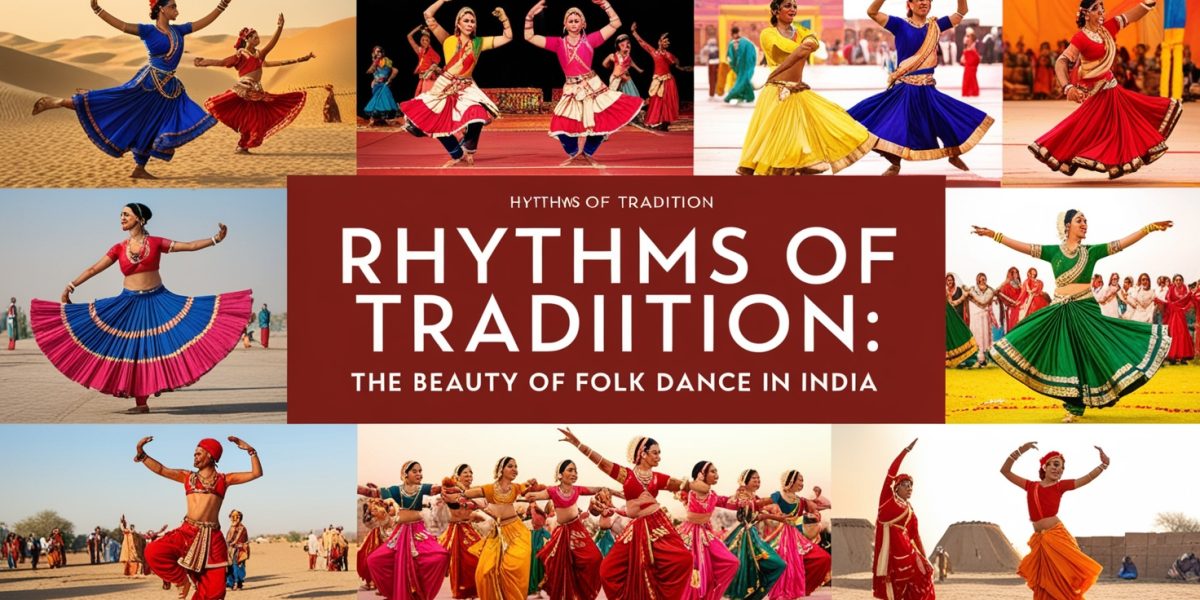India is a land of rich cultural diversity, where each region showcases its own unique art forms, traditions, and performances. Among these, folk dance holds a special place, often representing the very essence of a community’s heritage and lifestyle. These dances, passed down through generations, are an expression of joy, storytelling, and reverence for nature, seasons, and deities. One such captivating form is the folk dance in Jaisalmer, which brings together the rhythmic movements, colorful attire, and vibrant music of Rajasthan. From the intricate footwork to the spirited drum beats, folk dances in India, particularly in Rajasthan, offer a deep connection to the cultural roots of the land.
This blog will examine the beauty of Indian folk dance, its importance, the many styles seen in different parts of the country, and how these dances are crucial to maintaining the people’s cultural identity. Let’s examine why Indian folk dances are regarded as the country’s cultural lifeblood and how they contribute to preserving its diversity.
1. The Essence of Folk Dance: A Cultural Expression
Folk dance is more than just a kind of art; it’s a way for communities to communicate their everyday lives, seasonal variations, religious convictions, and historical narratives. Folk dance typically contains local variances and is impromptu, in contrast to classical dance, which has a set structure. Frequently performed at festivals, weddings, harvest seasons, and other communal events, it is intricately linked to the people’s way of life.
These dances are an ode to life. Circular motions indicate the cycle of life, quick footwork imitates animal or natural phenomena, and elegant gestures convey tales of love, toil, and devotion. These movements frequently portray different facets of nature.
2. Folk Dance Across India: A Kaleidoscope of Styles
There are many different types of folk dance in India, and each has its own unique taste, cultural background, and regional influences. Among the most well-known folk dancing styles are:
- Bhangra (Punjab): In Punjab, this exuberant dance is a representation of joy and harvest. Bhangra is now a worldwide dance style that has crossed regional boundaries with its upbeat sounds and colorful moves.
- Garba (Gujarat): The round dance known as Garba, which is performed during the Navratri festival, represents peace and the circle of life. It is frequently performed to the beat of hand claps and dhols.
- Dandiya (Gujarat): Dandiya is a dance, like Garba, in which dancers use sticks called dandiyas and move in unison in pairs to create a captivating visual show.
- Kathakali (Kerala): Rooted in Kerala’s religious and cultural traditions, Kathakali is a dramatic dance style that uses sophisticated footwork, ornate costumes, and facial expressions to tell stories.
- Lavani (Maharashtra): Lavani is renowned for its sensual movements and strong rhythms, which are performed to traditional music and frequently touch on topics of social difficulties, love, and life.
- Kuchipudi (Andhra Pradesh): Known for its emotive storytelling, elegant footwork, and hand gestures, Kuchipudi is a classical dance style that incorporates folk elements into its performances.
In Indian culture, each of these folk dances has a special position and provides insight into how various communities have commemorated their faith, history, and customs.
3. Folk Dance in Rajasthan: The Spirit of the Desert
Rajasthan is well-known for its colorful culture, regal past, and opulent architecture. Its rich folk dance heritage is as colorful as its desert surroundings. Over the years, these dances have changed in response to the distinct environment and way of life of the area. Rajasthan’s folk dances have a strong connection to the region, its people, and their everyday customs; they are more than merely artistic manifestations.
With its exuberance, elegance, and complex movements, Jaisalmer’s folk dance is especially a mesmerizing sight. Known as the “Golden City” because of its architecture made of yellow sandstone, Jaisalmer is the site of numerous folk dance styles that are performed at festivals, weddings, and social events.
The Kalbeliya and Ghoomar dances are the most well-known of these. Traditionally performed in circular patterns by ladies, ghoomar is an elegant dance with vibrant costumes and swirling moves. Known for their extensive snake-charming history, the Kalbeliya community performs the serpentine dance known as Kalbeliya. The dancer creates a captivating, rhythmic, and hypnotic performance by imitating the grace and fluidity of snakes with their moves.
4. The Role of Folk Dance in Preserving Tradition
India’s cultural legacy is preserved and promoted in large part through folk dance. It is a way of preserving history, ideals, and stories for the next generation. The habits, religious beliefs, and historical events of their ancestors are taught to young people through dancing.
In rural regions where traditional lifestyles are still prevalent, folk dancing is frequently performed as a component of religious and social ceremonies. Communities are able to stay connected to their cultural heritage and traditions through these dances. Even in metropolitan settings where contemporary influences are more noticeable, folk dance is still a significant cultural activity that supports Indian groups’ efforts to preserve their identity.
5. The Future of Folk Dance: Bridging Tradition and Modernity
India’s folk dance is changing with the times, even if it has stayed primarily traditional. Folk dance has evolved into a modern art form that is now featured in movies, TV series, and performances around the world. Due to this evolution, these dances have gained new life and are now popular among newer generations who are keen to commemorate and learn about their cultural history.
Dancers and performers from different states gather to display the beauty and uniqueness of their regional dance styles at folk dance festivals and cultural events that are becoming more and more popular throughout India. Such gatherings are essential to maintaining each folk tradition’s distinctiveness while also increasing its accessibility to a worldwide audience.
Conclusion
The beauty of folk dance in India lies in its diversity, its deep connection to the people, and its ability to preserve ancient traditions while adapting to modern times. Whether it is the Rajasthani folk dance in desert regions like Jaisalmer or the Bhangra of Punjab, these dances serve as a window into the culture and lifestyle of India’s diverse communities.
When we honor the rhythms of history, we must keep in mind that folk dance is a living tradition that inspires, unites, and connects people, not merely a performance art. It is a potent representation of India’s cultural legacy and an art form that will endure for many more years. We make sure that the enchantment of these lovely traditions will be experienced and appreciated by future generations by conserving and promoting folk dance.












